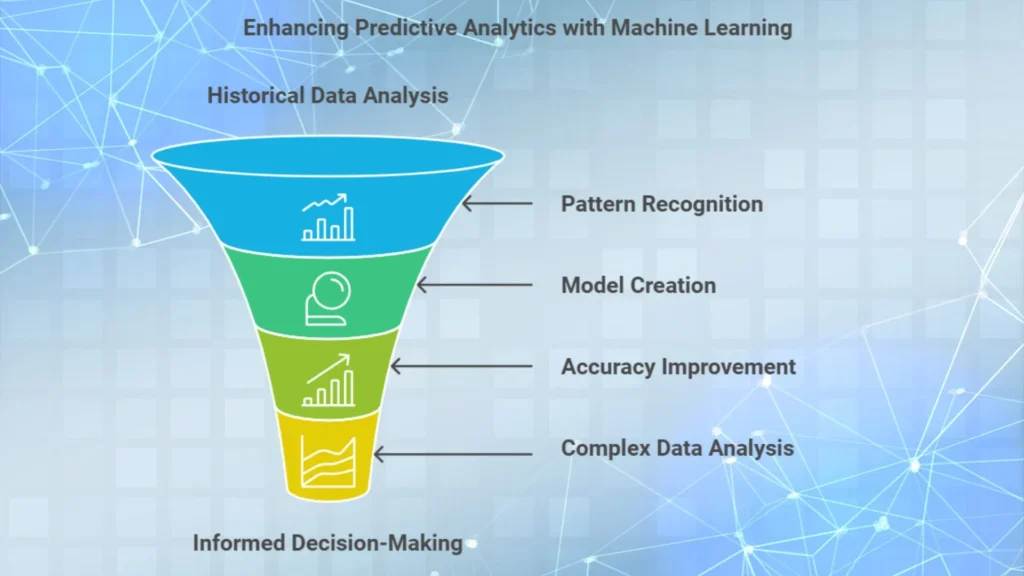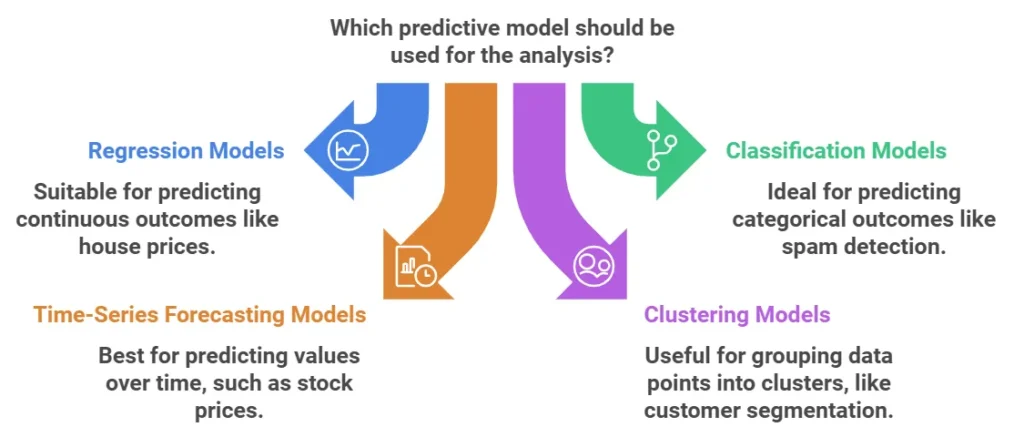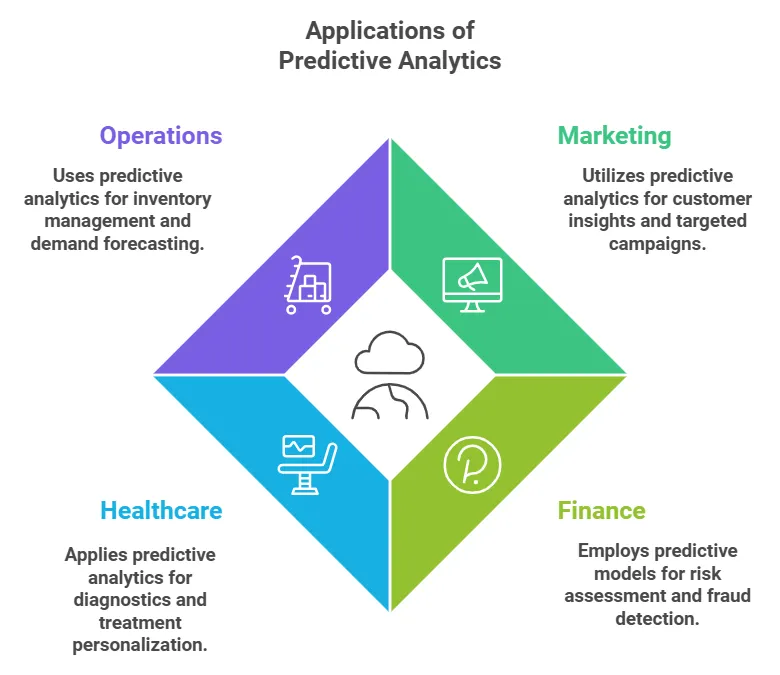Predictive analytics has rapidly evolved, moving from a specialized area of statistics to an essential part of everyday decision making across industries. At the heart of this evolution is machine learning (ML), a technology that enables systems to analyze large amounts of data, recognize patterns and make predictions with high accuracy.
This blog will explore the role of Machine Learning in predictive analytics, the types of predictive models it uses and real world applications in areas such as marketing, finance, healthcare and operations.
What Is Predictive Analytics?
Predictive analytics is a field of data science that uses statistical algorithms, data mining and machine learning to forecast future outcomes based on historical data. By analyzing patterns in past data, predictive analytics provides valuable information for informed decision making.
Machine learning has expanded the capabilities of predictive analytics, which automates the process of model creation, improves accuracy and enables the analysis of increasingly complex datasets.

How Machine Learning Enhances Predictive Analytics
Machine learning optimizes predictive analytics in several ways:
1. Automated Model Training: Machine learning algorithms can continuously learn from new data, which automatically improves the predictive model over time.
2. Handling Complex Data: Unlike traditional statistical methods, ML algorithms can handle large, complex and unstructured datasets, such as text, images and videos.
3. Higher Accuracy: ML algorithms like neural networks and ensemble methods often provide more accurate predictions compared to traditional statistical approaches.
4. Real-time Predictions: With ML, predictive models can process real time data, which enables businesses to make dynamic adjustments.
Machine Learning Techniques in Predictive Analytics
There are two main types of ML algorithms used in predictive analytics: supervised learning and unsupervised learning.
– Supervised Learning: Algorithms like regression and classification are trained on labeled data, which enables them to make accurate predictions.
– Unsupervised Learning: Used for data segmentation and pattern recognition, often applied in customer segmentation or clustering.
Types of Predictive Models in Machine Learning
Predictive analytics employs several types of models, each suited to specific types of predictions:
1. Regression Models
Regression models predict a continuous outcome based on input variables. For example, predicting a house price based on location, size and other characteristics is a regression method. Common regression techniques include:
– Linear Regression: Analyzes the relationship between a dependent variable and one or more independent variables.
– Polynomial Regression: Fits a nonlinear relationship by considering powers of the independent variables.
– Logistic Regression: Used for binary outcomes (like “yes” or “no” decisions) and is technically a classification algorithm.
Example: A real estate company might use linear regression to predict house prices based on factors like neighborhood, square footage and amenities.
2. Classification Models
Classification models predict categorical outcomes, such as “spam” or “not spam,” “high-risk” or “low-risk.” These models are widely used in applications where data can be segmented into distinct categories. For examples:
– Decision Trees: Uses a tree like model of decisions to classify data into categories.
– Random Forests: An ensemble method that combines multiple decision trees to improve prediction accuracy.
– Support Vector Machines (SVM): Classifies data by finding the best boundary that separates different classes.
Example: Financial institutions use classification models to identify potential fraud, which classifies transactions as either suspicious or non suspicious.
3. Time Series Forecasting Models
Time series forecasting is ideal for predicting values over time, such as stock prices, demand or temperature. These models account for trends, seasonality and cyclic patterns in data.
– ARIMA (Auto Regressive Integrated Moving Average): Widely used in econometrics and finance for forecasting trends.
– LSTM (Long Short-Term Memory Networks): A type of recurrent neural network (RNN) designed for sequence prediction, often used in deep learning for time series data.
Example: Retail companies use time-series forecasting to anticipate seasonal product demand, to adjust inventory accordingly.
4. Clustering Models
Clustering models group data points into clusters based on their similarities. This is particularly useful in customer segmentation, anomaly detection and image recognition.
– K-Means Clustering: Divides data into clusters based on the nearest mean value.
– Hierarchical Clustering: Builds a hierarchy of clusters, ideal for understanding relationships between data points.
Example: E-commerce platforms use clustering to segment customers based on browsing behavior, which enables them for more targeted marketing strategies.

Applications of Predictive Analytics Across Industries
Let us explore how machine learning powered predictive analytics is being applied in various industries:
1. Marketing: Personalized Recommendations and Customer Insights
Predictive analytics in marketing helps businesses to understand customer behavior, anticipate needs and improve campaign effectiveness.
– Customer Segmentation: Clustering models group customers based on behavior, demographics and purchase history, to enable targeted marketing.
– Churn Prediction: Machine learning models identify customers likely to leave, which allows companies to intervene with personalized offers.
– Recommendation Engines: Predictive models recommend products or services based on previous customer interactions, to increase engagement and sales.
– Tools: Google Analytics and HubSpot offer predictive analytics features that help marketing teams forecast customer behavior and optimize campaigns.
2. Finance: Risk Assessment and Fraud Detection
Machine learning’s predictive capabilities are valuable in finance, where decisions need to be accurate and timely.
– Fraud Detection: Classification models identify suspicious transactions, to reduce fraud and protect customers.
– Credit Scoring: Machine learning predicts the creditworthiness of borrowers, which enables better lending decisions.
– Investment Forecasting: Time series models forecast stock and commodity prices, to make investment strategies.
– Case Study: PayPal uses machine learning based predictive analytics for fraud detection. By analyzing transaction patterns, it can pin point potentially fraudulent activity quickly, to protect users from unauthorized transactions.
3. Healthcare: Predictive Diagnostics and Treatment Personalization
In healthcare, predictive analytics helps to improve patient care, reduce costs and predict disease outcomes.
– Disease Diagnosis: Machine learning analyzes medical records and imaging data to diagnose diseases like cancer, heart disease and diabetes.
– Predictive Maintenance: In hospital settings, predictive models ensure that essential medical equipment is maintained before failures occur.
– Patient Outcome Prediction: Predictive analytics helps foresee patient responses to treatment, to provide personalized healthcare plans.
– Case Study: IBM Watson Health is an example of predictive analytics in action. By analyzing medical histories, lab reports and imaging data, Watson provides personalized treatment recommendations, to enhance diagnostic accuracy.
4. Operations: Inventory Management and Demand Forecasting
Predictive analytics streamlines operations by forecasting demand, improving supply chain efficiency and minimizing downtime.
– Inventory Management: Time series forecasting predicts product demand, which ensures that stock levels are optimized to meet customer needs.
– Predictive Maintenance: ML models anticipate when machinery or equipment will need servicing, to reduce unexpected downtimes.
– Supply Chain Optimization: Predictive analytics identifies potential bottlenecks, which enables to take proactive measures to avoid delays.
– Tools: SAP Integrated Business Planning and Microsoft Azure Machine Learning are popular tools for demand forecasting and inventory optimization, which help businesses to manage their supply chains efficiently.

Popular Tools and Technologies for Predictive Analytics
Several powerful tools are available today that make predictive analytics available to businesses of all sizes. Here is a look at some popular tools that incorporate machine learning for predictive analysis:
1. IBM SPSS Modeler
IBM SPSS Modeler is designed for data scientists, which offers an intuitive drag-and-drop interface for building predictive models. It supports multiple data sources and provides strong machine learning algorithms for predictive analytics.
– Features: Data preparation, automated machine learning (AutoML), integration with IBM Watson.
– IBM Watson: It is a powerful tool for predictive analytics, particularly for personalized patient treatment and diagnostics.
– Ideal for: Business analysts, marketing professionals, healthcare.
2. Microsoft Azure Machine Learning
Azure Machine Learning is a cloud based platform that simplifies model building, training and deployment. It offers a comprehensive set of ML tools and integrates well with other Azure services.
– Features: Automated ML, scalable model deployment, supports popular ML frameworks like TensorFlow and PyTorch.
– Ideal for: Large enterprises, healthcare, finance.
3. Google BigQuery
BigQuery by Google is a powerful data warehouse solution that integrates machine learning capabilities, which enables predictive analytics on large datasets.
– Features: Fast querying, scalable infrastructure, built in ML capabilities.
– Ideal for: Enterprises handling big data, marketing, operations.
4. Tableau with R/Python Integration
Tableau is known for its data visualization capabilities and with integrations to R and Python, it can also perform predictive analytics. It is an accessible tool for generating tips from data.
– Features: Data visualization, ML integration, easy data manipulation.
– Ideal for: Marketing, retail, finance etc.
5. RapidMiner:
A data science platform known for ease of use, RapidMiner helps organizations build ML models without requiring special coding expertise.
Challenges and Considerations in Predictive Analytics
Despite the promise of predictive analytics, there are challenges to keep in mind:
1. Data Quality and Cleanliness
Poor quality data can lead to inaccurate predictions. Need to ensure that, data is complete, accurate and free from any bias.
2. Privacy and Compliance
Industries like finance and healthcare have strict regulations concerning data privacy. Predictive analytics projects must comply with these standards to protect customer data.
3. Interpretability of ML Models
Certain ML models, especially deep learning algorithms, can be difficult to interpret. For important decisions, such as medical diagnoses, this nature of some models can pose a challenge.
4. Overfitting and Underfitting
When building predictive models, there is always a risk of overfitting (model too specific to training data) or underfitting (model too simplistic). Proper validation techniques and model tuning can mitigate these risks.
Real World Case Studies in Predictive Analytics
Case Study 1: Netflix’s Recommendation Engine
Netflix uses predictive analytics to suggest shows and movies based on a user’s viewing history, ratings and even the time of day. This recommendation system, powered by ML algorithms, has been highly successful, which keeps viewers engaged and increase customer retention.
Case Study 2: Predictive Maintenance in Airlines
Airlines utilize predictive analytics to anticipate maintenance needs. By analyzing flight data, engine performance and repair history, airlines can predict equipment failures and schedule maintenance, which minimizes downtime and improves safety.
Future of Machine Learning in Predictive Analytics
Machine learning’s role in predictive analytics will only grow as data volumes increase and computational power advances. Here are some predictions:
1. Real time Analytics: As data collection and processing speed goes up, businesses will benefit from real time predictive insights, particularly in industries like finance and e-commerce.
2. Integration with IoT: Internet of Things (IoT) devices are collecting large amounts of real time data. Integrating predictive analytics with IoT could revolutionize industries such as manufacturing, agriculture and healthcare.
3. Personalized Predictive Models: Predictive models will become more suitable to individual users, particularly in areas like personalized medicine and customer experience, which will provide even more relevant recommendations and treatment plans.
Conclusion
Machine learning has transformed predictive analytics into a dynamic, adaptable tool for forecasting future outcomes across industries. Predictive analytics powered by ML offers a data driven approach to decision making that increases efficiency, reduces risks and enhances customer experiences. Understanding the role of machine learning in predictive analytics opens up a world of possibilities for innovation and growth.
By choosing the right predictive models and using powerful analytics tools, businesses can discover valuable information and stay ahead of their competition.

